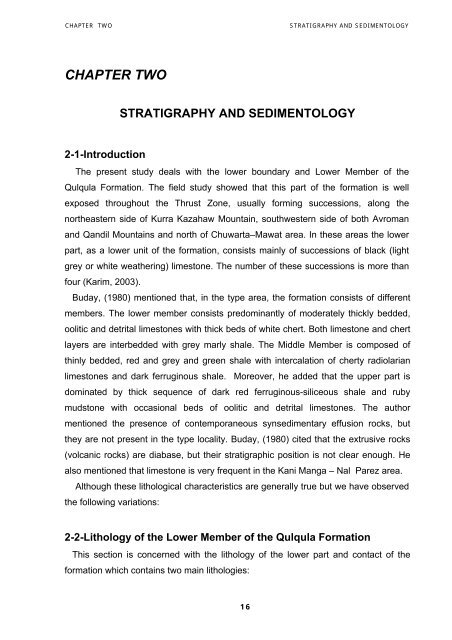a conglomerte bed as a possible lower boundary - Professor Kamal ...
a conglomerte bed as a possible lower boundary - Professor Kamal ...
a conglomerte bed as a possible lower boundary - Professor Kamal ...
You also want an ePaper? Increase the reach of your titles
YUMPU automatically turns print PDFs into web optimized ePapers that Google loves.
CHAPTER TWO<br />
STRATIGRAPHY AND SEDIMENTOLOGY<br />
CHAPTER TWO<br />
STRATIGRAPHY AND SEDIMENTOLOGY<br />
2-1-Introduction<br />
The present study deals with the <strong>lower</strong> <strong>boundary</strong> and Lower Member of the<br />
Qulqula Formation. The field study showed that this part of the formation is well<br />
exposed throughout the Thrust Zone, usually forming successions, along the<br />
northe<strong>as</strong>tern side of Kurra Kazahaw Mountain, southwestern side of both Avroman<br />
and Qandil Mountains and north of Chuwarta–Mawat area. In these are<strong>as</strong> the <strong>lower</strong><br />
part, <strong>as</strong> a <strong>lower</strong> unit of the formation, consists mainly of successions of black (light<br />
grey or white weathering) limestone. The number of these successions is more than<br />
four (Karim, 2003).<br />
Buday, (1980) mentioned that, in the type area, the formation consists of different<br />
members. The <strong>lower</strong> member consists predominantly of moderately thickly <strong>bed</strong>ded,<br />
oolitic and detrital limestones with thick <strong>bed</strong>s of white chert. Both limestone and chert<br />
layers are inter<strong>bed</strong>ded with grey marly shale. The Middle Member is composed of<br />
thinly <strong>bed</strong>ded, red and grey and green shale with intercalation of cherty radiolarian<br />
limestones and dark ferruginous shale. Moreover, he added that the upper part is<br />
dominated by thick sequence of dark red ferruginous-siliceous shale and ruby<br />
mudstone with occ<strong>as</strong>ional <strong>bed</strong>s of oolitic and detrital limestones. The author<br />
mentioned the presence of contemporaneous synsedimentary effusion rocks, but<br />
they are not present in the type locality. Buday, (1980) cited that the extrusive rocks<br />
(volcanic rocks) are diab<strong>as</strong>e, but their stratigraphic position is not clear enough. He<br />
also mentioned that limestone is very frequent in the Kani Manga – Nal Parez area.<br />
Although these lithological characteristics are generally true but we have observed<br />
the following variations:<br />
2-2-Lithology of the Lower Member of the Qulqula Formation<br />
This section is concerned with the lithology of the <strong>lower</strong> part and contact of the<br />
formation which contains two main lithologies:<br />
16
















